Podcast
Questions and Answers
What is one way that enzymes accelerate chemical reactions?
What is one way that enzymes accelerate chemical reactions?
- By bringing substrates into close proximity (correct)
- By increasing the concentration of substrates
- By inhibiting the reverse reaction
- By reducing the temperature of the reaction
What happens to the enzyme after a reaction is completed?
What happens to the enzyme after a reaction is completed?
- It cannot bind to another substrate
- It gets consumed along with the substrate
- It changes permanently
- It remains unchanged (correct)
In what way does the induced fit model relate to enzyme activity?
In what way does the induced fit model relate to enzyme activity?
- It results in a conformational change in the enzyme (correct)
- It allows the substrate to bind without any changes
- It inhibits substrate binding
- It maintains the enzyme's original shape
At equilibrium during an enzyme-catalyzed reaction, what is true about the forward and reverse reactions?
At equilibrium during an enzyme-catalyzed reaction, what is true about the forward and reverse reactions?
Which mechanism describes how the binding of the substrate affects the enzyme's shape?
Which mechanism describes how the binding of the substrate affects the enzyme's shape?
What is a consequence of the high concentration of product in an enzyme reaction mixture?
What is a consequence of the high concentration of product in an enzyme reaction mixture?
Why is it stated that enzyme-catalyzed reactions are theoretically reversible?
Why is it stated that enzyme-catalyzed reactions are theoretically reversible?
What role does the catalytic group play in enzyme function?
What role does the catalytic group play in enzyme function?
What is the primary role of enzymes in biochemical reactions?
What is the primary role of enzymes in biochemical reactions?
Which statement accurately describes the transition state in enzyme reactions?
Which statement accurately describes the transition state in enzyme reactions?
What type of catalysis involves the active site of an enzyme acting as a proton donor?
What type of catalysis involves the active site of an enzyme acting as a proton donor?
Why do some enzymes form unstable enzyme-substrate complexes?
Why do some enzymes form unstable enzyme-substrate complexes?
What defines the activation energy in enzymatic reactions?
What defines the activation energy in enzymatic reactions?
Which of the following best describes covalent catalysis?
Which of the following best describes covalent catalysis?
How does the free energy of activation relate to catalysis?
How does the free energy of activation relate to catalysis?
What is one effect of enzyme catalysis in reactions?
What is one effect of enzyme catalysis in reactions?
What is the role of a catalyst in a chemical reaction?
What is the role of a catalyst in a chemical reaction?
What happens to the enzyme after a product is formed?
What happens to the enzyme after a product is formed?
Which statement about the energy of activation is correct?
Which statement about the energy of activation is correct?
How does the presence of an enzyme affect the reaction's overall free energy change?
How does the presence of an enzyme affect the reaction's overall free energy change?
What is the transient state formed when a substrate combines with a catalyst called?
What is the transient state formed when a substrate combines with a catalyst called?
What must the substrate possess for a reaction to occur?
What must the substrate possess for a reaction to occur?
In the context of enzyme-catalyzed reactions, what is meant by 'transition state'?
In the context of enzyme-catalyzed reactions, what is meant by 'transition state'?
What does the energy required to bring all molecules in one gram mole to a given state represent?
What does the energy required to bring all molecules in one gram mole to a given state represent?
What is formed when an enzyme binds with a substrate?
What is formed when an enzyme binds with a substrate?
Which component of an enzyme specifically binds to the substrate during the catalytic process?
Which component of an enzyme specifically binds to the substrate during the catalytic process?
What type of interaction primarily stabilizes the enzyme-substrate complex?
What type of interaction primarily stabilizes the enzyme-substrate complex?
In terms of size comparison, how do enzymes relate to their substrates?
In terms of size comparison, how do enzymes relate to their substrates?
What is the purpose of the active site of an enzyme?
What is the purpose of the active site of an enzyme?
Which feature distinguishes the active center of an enzyme?
Which feature distinguishes the active center of an enzyme?
What is the role of transitional (intermediate) compounds in enzyme activity?
What is the role of transitional (intermediate) compounds in enzyme activity?
Which type of amino acid group is important for the active sites of enzymes?
Which type of amino acid group is important for the active sites of enzymes?
What is the primary role of the enzyme-substrate complex?
What is the primary role of the enzyme-substrate complex?
Which statement accurately describes the enzyme's function after the substrate is transformed?
Which statement accurately describes the enzyme's function after the substrate is transformed?
What key interaction is compared to the relationship between an enzyme and its substrate?
What key interaction is compared to the relationship between an enzyme and its substrate?
According to the Michaelis-Menten theory, what is formed when an enzyme combines with its substrate?
According to the Michaelis-Menten theory, what is formed when an enzyme combines with its substrate?
Which amino acids are mentioned as present at the active site of enzymes?
Which amino acids are mentioned as present at the active site of enzymes?
What is the immediate product of the reaction catalyzed by the enzyme after the enzyme-substrate complex is formed?
What is the immediate product of the reaction catalyzed by the enzyme after the enzyme-substrate complex is formed?
In enzyme kinetics, what does the term 'active site' refer to?
In enzyme kinetics, what does the term 'active site' refer to?
What describes the process of the enzyme returning to its original state after catalyzing a reaction?
What describes the process of the enzyme returning to its original state after catalyzing a reaction?
Flashcards
Active Site
Active Site
The specific region on an enzyme where the substrate binds.
Enzyme-Substrate Complex
Enzyme-Substrate Complex
A temporary complex formed when an enzyme binds to its substrate.
Michaelis-Menten Theory
Michaelis-Menten Theory
The model that explains how enzymes work by binding to their substrates, forming an enzyme-substrate complex.
Substrate
Substrate
Signup and view all the flashcards
Product
Product
Signup and view all the flashcards
Michaelis Constant (Km)
Michaelis Constant (Km)
Signup and view all the flashcards
Vmax
Vmax
Signup and view all the flashcards
Active Site Amino Acids
Active Site Amino Acids
Signup and view all the flashcards
Enzyme-Substrate Complex (ES)
Enzyme-Substrate Complex (ES)
Signup and view all the flashcards
Catalytic Site
Catalytic Site
Signup and view all the flashcards
Enzyme Catalysis
Enzyme Catalysis
Signup and view all the flashcards
Specificity of Enzyme Action
Specificity of Enzyme Action
Signup and view all the flashcards
Binding Interactions
Binding Interactions
Signup and view all the flashcards
Transitional (Intermediate) Compound
Transitional (Intermediate) Compound
Signup and view all the flashcards
Stabilizing Forces
Stabilizing Forces
Signup and view all the flashcards
Enzyme Reusability
Enzyme Reusability
Signup and view all the flashcards
Enzyme Reaction Reversibility
Enzyme Reaction Reversibility
Signup and view all the flashcards
Enzyme Acceleration
Enzyme Acceleration
Signup and view all the flashcards
Proximity and Orientation
Proximity and Orientation
Signup and view all the flashcards
Strain and Distortion
Strain and Distortion
Signup and view all the flashcards
Induced Fit Model
Induced Fit Model
Signup and view all the flashcards
Activation Energy
Activation Energy
Signup and view all the flashcards
Transition State
Transition State
Signup and view all the flashcards
Catalyst
Catalyst
Signup and view all the flashcards
Enzyme
Enzyme
Signup and view all the flashcards
Free Energy Change
Free Energy Change
Signup and view all the flashcards
Effect of Enzyme on Activation Energy
Effect of Enzyme on Activation Energy
Signup and view all the flashcards
General Acid-Base Catalysis
General Acid-Base Catalysis
Signup and view all the flashcards
Covalent Catalysis
Covalent Catalysis
Signup and view all the flashcards
Effect of Catalysis
Effect of Catalysis
Signup and view all the flashcards
Enzymes Stabilize Transition State
Enzymes Stabilize Transition State
Signup and view all the flashcards
Conformational Change
Conformational Change
Signup and view all the flashcards
Study Notes
Enzyme Action Mechanism
- Enzymes act by forming a temporary complex with the substrate
- The enzyme-substrate complex (ES) lowers the activation energy needed for the reaction
- The substrate is converted into product(s)
- The enzyme is unchanged after the reaction
Enzyme-Substrate Complex (ES)
- The enzyme and substrate bind at the active site
- The binding involves specific interactions (e.g., hydrogen bonds, ionic interactions)
- The binding causes the substrate's shape to change slightly (induced fit model)
Michaelis-Menten Equation
- Describes the relationship between substrate concentration, enzyme concentration and reaction rate
- Defines the maximum velocity (Vmax) and the Michaelis constant (Km)
- Km represents the substrate concentration at which the reaction rate is half of Vmax
Factors Affecting Enzyme Activity
- Temperature: Optimum temperature exists, higher temperatures denature enzymes
- pH: Enzymes have optimal pH values
- Substrate concentration: Increasing substrate amount increases reaction rate to Vmax
- Enzyme concentration: Higher enzyme concentration, faster reaction to Vmax
- Inhibitors: Substances can inhibit enzyme activity (competitive or non-competitive)
Enzyme Structure and Function
- Enzymes are proteins with a specific 3D structure
- The active site is a crucial region for substrate binding
- The active site's shape and chemical properties are unique to each enzyme, allowing it to catalyze only particular reactions
- The active site's structure allows interactions with the substrate, facilitating the reaction
Enzyme Catalysis Mechanisms
- Enzymes lower activation energy by bringing substrates together
- Proximity: Orienting molecules properly to facilitate bonding
- Straining the substrate: Altering substrate shape for easier bond breaking
- General acid/base catalysis: Enzyme donates/accepts protons to alter substrate
- Covalent catalysis: Enzyme forms temporary covalent bonds with substrate to increase reaction rate
- Induced fit: the enzyme's active site molds to the substrate's shape
Studying That Suits You
Use AI to generate personalized quizzes and flashcards to suit your learning preferences.




